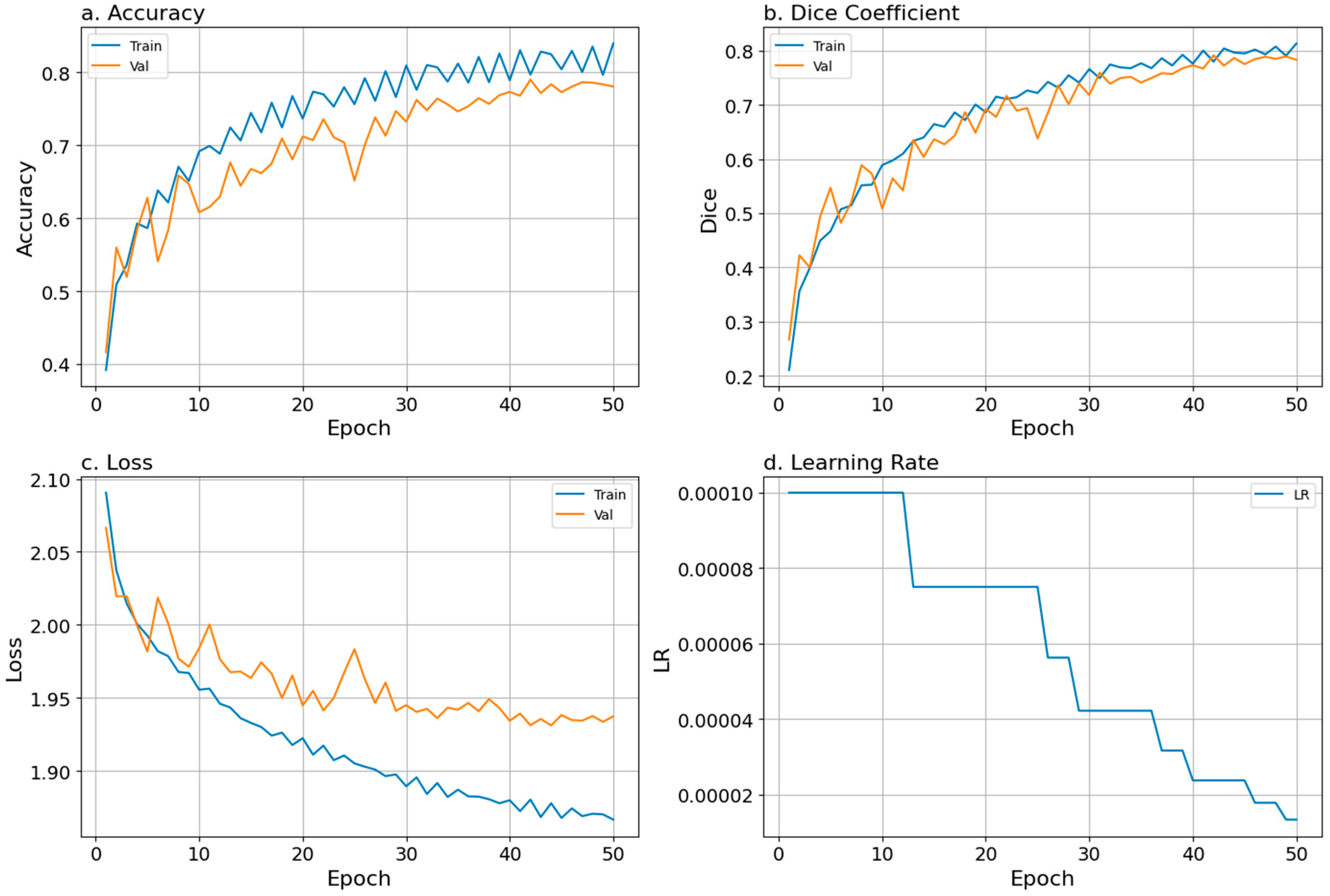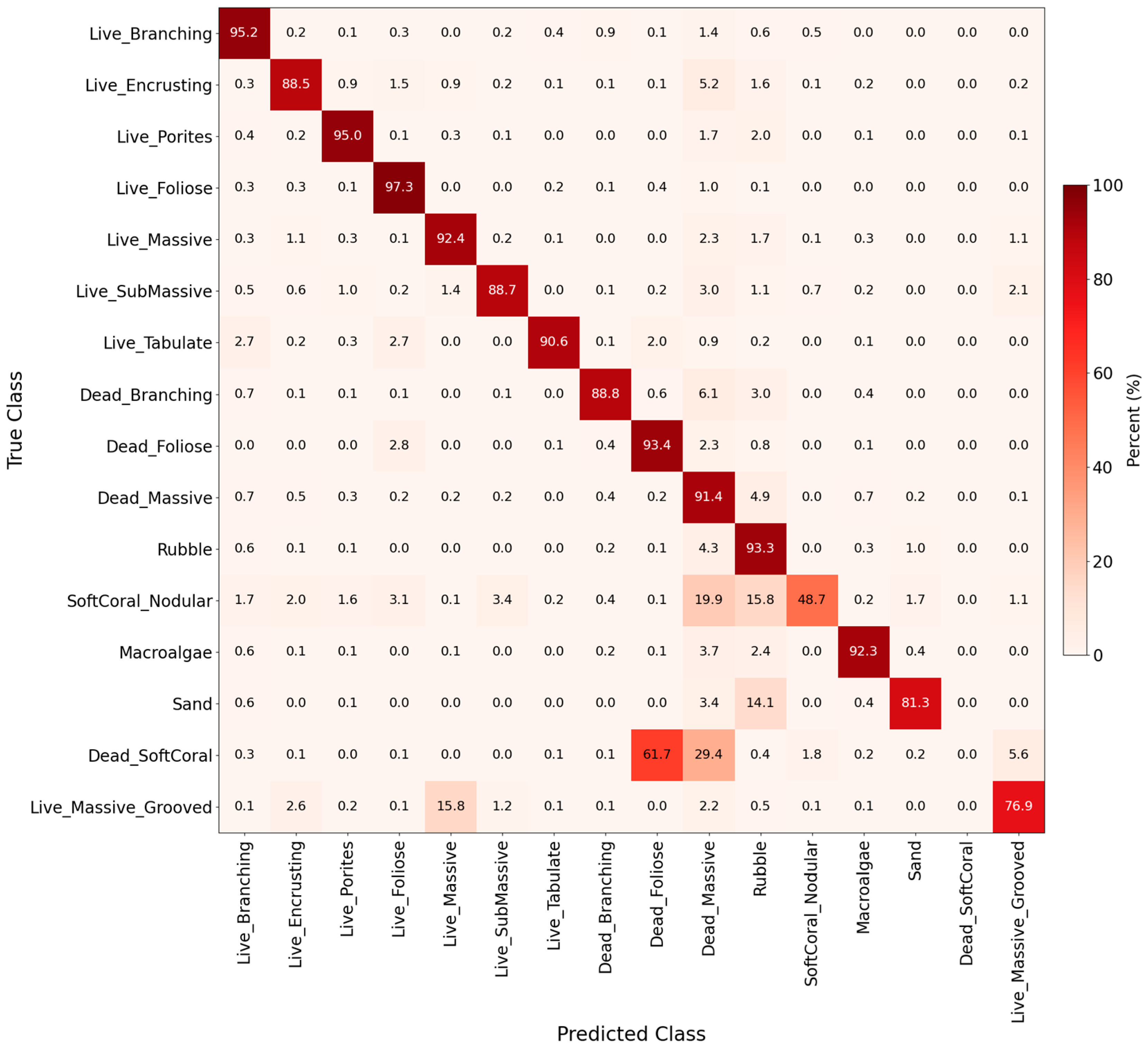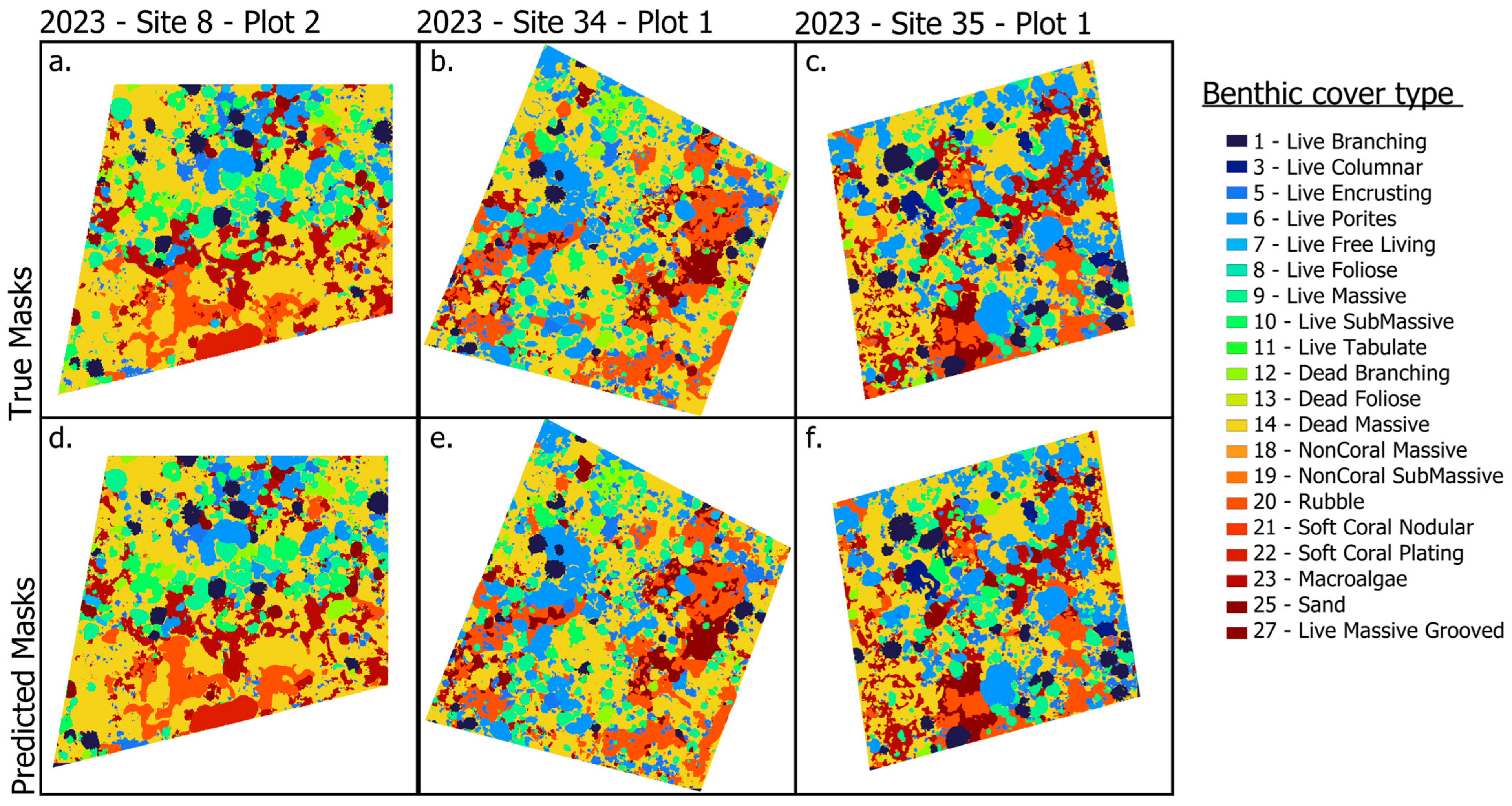Semantic Segmentation of Coral Reefs Using Convolutional Neural Networks: A Case Study in Kiritimati, Kiribati
Highlights
- We developed and trained ResNet101-SCSE-U-Net for semantic segmentation of 16 benthic reef classes, achieving 84% overall accuracy, and modifications to the model were able to handle the highly unbalanced training data.
- The trained model was successfully applied to 27 unlabeled plots from 2023, demonstrating strong generalizability and providing a tool for automated monitoring of new reef surveys.
- We provide a reproducible, step-by-step pipeline for fully supervised deep learning-based annotation of coral reef imagery, reducing the reliance on manual labeling by experts.
- The pipeline and trained models can be transferred across reef environments, capturing ecological variation and enabling fully automated, high-resolution classification of benthic communities.
Abstract
1. Introduction
2. Methods
2.1. Data Acquisition: Study Site, Plots, and Mega Photo Quadrats
2.2. Data Preprocessing: 3D Models, Benthic Community Digitization, and Data Conversion
2.3. Data Processing: Training Pipeline, U-Net Modifications, and Building the Model
2.3.1. Training, Validation, and Testing Pipeline
2.3.2. CNN Model Architecture Implementation
2.4. Data Post-Processing: Validation, Overfitting, and Model Comparison
2.5. Applications to New Data
3. Results
3.1. Model Performance
3.2. Model Outputs and Application to New Data
4. Discussion
4.1. Automation of Annotated Coral Reef 3D Modeling
4.2. Comparison with Recent Literature
4.3. Model Improvements, Limitations, and Benchmark Comparisons
4.4. Application to New Data and Ecological Implications
5. Conclusions
Supplementary Materials
Author Contributions
Funding
Data Availability Statement
Acknowledgments
Conflicts of Interest
References
- Graham, N.A.J.; Nash, K.L. The Importance of Structural Complexity in Coral Reef Ecosystems. Coral Reefs 2013, 32, 315–326. [Google Scholar] [CrossRef]
- Graham, N.A.J.; Jennings, S.; MacNeil, M.A.; Mouillot, D.; Wilson, S.K. Predicting Climate-Driven Regime Shifts versus Rebound Potential in Coral Reefs. Nature 2015, 518, 94–97. [Google Scholar] [CrossRef]
- Sheppard, C.; Dixon, D.J.; Gourlay, M.; Sheppard, A.; Payet, R. Coral Mortality Increases Wave Energy Reaching Shores Protected by Reef Flats: Examples from the Seychelles. Estuar. Coast. Shelf Sci. 2005, 64, 223–234. [Google Scholar] [CrossRef]
- Richardson, L.E.; Graham, N.A.J.; Hoey, A.S. Cross-Scale Habitat Structure Driven by Coral Species Composition on Tropical Reefs. Sci. Rep. 2017, 7, 7557. [Google Scholar] [CrossRef]
- Wilson, S.K.; Graham, N.A.J.; Pratchett, M.S.; Jones, G.P.; Polunin, N.V.C. Multiple Disturbances and the Global Degradation of Coral Reefs: Are Reef Fishes at Risk or Resilient? Glob. Change Biol. 2006, 12, 2220–2234. [Google Scholar] [CrossRef]
- Cinner, J.E.; McClanahan, T.R.; Daw, T.M.; Graham, N.A.J.; Maina, J.; Wilson, S.K.; Hughes, T.P. Linking Social and Ecological Systems to Sustain Coral Reef Fisheries. Curr. Biol. 2009, 19, 206–212. [Google Scholar] [CrossRef]
- Graham, N.A.J.; Wilson, S.K.; Pratchett, M.S.; Polunin, N.V.C.; Spalding, M.D. Coral Mortality versus Structural Collapse as Drivers of Corallivorous Butterflyfish Decline. Biodivers. Conserv. 2009, 18, 3325–3336. [Google Scholar] [CrossRef]
- Stachowicz, J.J. Mutualism, Facilitation, and the Structure of Ecological Communities. BioScience 2001, 51, 235. [Google Scholar] [CrossRef]
- Burns, J.H.R.; Fukunaga, A.; Pascoe, K.H.; Runyan, A.; Craig, B.K.; Talbot, J.; Pugh, A.; Kosaki, R.K. 3D Habitat Complexity of Coral Reefs in the Northwestern Hawaiian Islands Is Driven by Coral Assemblage Structure. Int. Arch. Photogramm. Remote Sens. Spat. Inf. Sci. 2019, 42, 61–67. [Google Scholar] [CrossRef]
- Holbrook, S.J.; Adam, T.C.; Edmunds, P.J.; Schmitt, R.J.; Carpenter, R.C.; Brooks, A.J.; Lenihan, H.S.; Briggs, C.J. Recruitment Drives Spatial Variation in Recovery Rates of Resilient Coral Reefs. Sci. Rep. 2018, 8, 7338. [Google Scholar] [CrossRef]
- Purkis, S.J.; Graham, N.A.J.; Riegl, B.M. Predictability of Reef Fish Diversity and Abundance Using Remote Sensing Data in Diego Garcia (Chagos Archipelago). Coral Reefs 2008, 27, 167–178. [Google Scholar] [CrossRef]
- Fukunaga, A.; Kosaki, R.K.; Wagner, D.; Kane, C. Structure of Mesophotic Reef Fish Assemblages in the Northwestern Hawaiian Islands. PLoS ONE 2016, 11, e0157861. [Google Scholar] [CrossRef]
- Fukunaga, A.; Burns, J.H.R. Metrics of Coral Reef Structural Complexity Extracted from 3D Mesh Models and Digital Elevation Models. Remote Sens. 2020, 12, 2676. [Google Scholar] [CrossRef]
- Komyakova, V.; Munday, P.L.; Jones, G.P. Relative Importance of Coral Cover, Habitat Complexity and Diversity in Determining the Structure of Reef Fish Communities. PLoS ONE 2013, 8, e83178. [Google Scholar] [CrossRef]
- Burns, J.; Delparte, D.; Gates, R.; Takabayashi, M. Integrating Structure-from-Motion Photogrammetry with Geospatial Software as a Novel Technique for Quantifying 3D Ecological Characteristics of Coral Reefs. PeerJ 2015, 3, e1077. [Google Scholar] [CrossRef]
- Iglhaut, J.; Cabo, C.; Puliti, S.; Piermattei, L.; O’Connor, J.; Rosette, J. Structure from Motion Photogrammetry in Forestry: A Review. Curr. For. Rep. 2019, 5, 155–168. [Google Scholar] [CrossRef]
- Magel, J.M.T.; Burns, J.H.R.; Gates, R.D.; Baum, J.K. Effects of Bleaching-Associated Mass Coral Mortality on Reef Structural Complexity across a Gradient of Local Disturbance. Sci. Rep. 2019, 9, 2512. [Google Scholar] [CrossRef]
- Schürholz, D.; Chennu, A. Digitizing the Coral Reef: Machine Learning of Underwater Spectral Images Enables Dense Taxonomic Mapping of Benthic Habitats. Methods Ecol. Evol. 2023, 14, 596–613. [Google Scholar] [CrossRef]
- Besson, M.; Alison, J.; Bjerge, K.; Gorochowski, T.E.; Høye, T.T.; Jucker, T.; Mann, H.M.R.; Clements, C.F. Towards the Fully Automated Monitoring of Ecological Communities. Ecol. Lett. 2022, 25, 2753–2775. [Google Scholar] [CrossRef]
- Keitt, T.H.; Abelson, E.S. Ecology in the Age of Automation. Science 2021, 373, 858–859. [Google Scholar] [CrossRef]
- Garcia-Garcia, A.; Orts-Escolano, S.; Oprea, S.; Villena-Martinez, V.; Garcia-Rodriguez, J. A Review on Deep Learning Techniques Applied to Semantic Segmentation. arXiv 2017, arXiv:1704.06857. [Google Scholar] [CrossRef]
- Marini, S.; Gjeci, N.; Govindaraj, S.; But, A.; Sportich, B.; Ottaviani, E.; Márquez, F.P.G.; Bernalte Sanchez, P.J.; Pedersen, J.; Clausen, C.V.; et al. ENDURUNS: An Integrated and Flexible Approach for Seabed Survey Through Autonomous Mobile Vehicles. J. Mar. Sci. Eng. 2020, 8, 633. [Google Scholar] [CrossRef]
- Juniper, S.K.; Matabos, M.; Mihály, S.; Ajayamohan, R.S.; Gervais, F.; Bui, A.O.V. A Year in Barkley Canyon: A Time-Series Observatory Study of Mid-Slope Benthos and Habitat Dynamics Using the NEPTUNE Canada Network. Deep Sea Res. Part II Top. Stud. Oceanogr. 2013, 92, 114–123. [Google Scholar] [CrossRef]
- Bicknell, A.W.; Godley, B.J.; Sheehan, E.V.; Votier, S.C.; Witt, M.J. Camera Technology for Monitoring Marine Biodiversity and Human Impact. Front. Ecol. Environ. 2016, 14, 424–432. [Google Scholar] [CrossRef]
- Danovaro, R.; Fanelli, E.; Aguzzi, J.; Billett, D.; Carugati, L.; Corinaldesi, C.; Dell’Anno, A.; Gjerde, K.; Jamieson, A.J.; Kark, S.; et al. Ecological Variables for Developing a Global Deep-Ocean Monitoring and Conservation Strategy. Nat. Ecol. Evol. 2020, 4, 181–192. [Google Scholar] [CrossRef]
- Harrison, D.; De Leo, F.C.; Gallin, W.J.; Mir, F.; Marini, S.; Leys, S.P. Machine Learning Applications of Convolutional Neural Networks and Unet Architecture to Predict and Classify Demosponge Behavior. Water 2021, 13, 2512. [Google Scholar] [CrossRef]
- Williams, I.D.; Couch, C.S.; Beijbom, O.; Oliver, T.A.; Vargas-Angel, B.; Schumacher, B.D.; Brainard, R.E. Leveraging Automated Image Analysis Tools to Transform Our Capacity to Assess Status and Trends of Coral Reefs. Front. Mar. Sci. 2019, 6, 222. [Google Scholar] [CrossRef]
- Lozada-Misa, P.; Schumacher, B.; Vargas-Ángel, B. Analysis of Benthic Survey Images via CoralNet: A Summary of Standard Operating Procedures and Guide-Lines; Pacific Islands Fisheries Science Center administrative report H 17-02; Pacific Islands Fisheries Science Center (U.S.): Honolulu, HI, USA, 2017. [CrossRef]
- Pavoni, G.; Corsini, M.; Ponchio, F.; Muntoni, A.; Edwards, C.; Pedersen, N.; Sandin, S.; Cignoni, P. TagLab: AI-assisted Annotation for the Fast and Accurate Semantic Segmentation of Coral Reef Orthoimages. J. Field Robot. 2022, 39, 246–262. [Google Scholar] [CrossRef]
- Hopkinson, B.M.; King, A.C.; Owen, D.P.; Johnson-Roberson, M.; Long, M.H.; Bhandarkar, S.M. Automated Classification of Three-Dimensional Reconstructions of Coral Reefs Using Convolutional Neural Networks. PLoS ONE 2020, 15, e0230671. [Google Scholar] [CrossRef]
- Stone, A.; Hickey, S.; Radford, B.; Wakeford, M. Mapping Emergent Coral Reefs: A Comparison of Pixel- and Object-based Methods. Remote Sens. Ecol. Conserv. 2025, 11, 20–39. [Google Scholar] [CrossRef]
- Remmers, T.; Boutros, N.; Wyatt, M.; Gordon, S.; Toor, M.; Roelfsema, C.; Fabricius, K.; Grech, A.; Lechene, M.; Ferrari, R. RapidBenthos: Automated Segmentation and Multi-view Classification of Coral Reef Communities from Photogrammetric Reconstruction. Methods Ecol. Evol. 2025, 16, 427–441. [Google Scholar] [CrossRef]
- Runyan, H.; Petrovic, V.; Edwards, C.B.; Pedersen, N.; Alcantar, E.; Kuester, F.; Sandin, S.A. Automated 2D, 2.5D, and 3D Segmentation of Coral Reef Pointclouds and Orthoprojections. Front. Robot. AI 2022, 9, 884317. [Google Scholar] [CrossRef]
- Raine, S.; Marchant, R.; Kusy, B.; Maire, F.; Fischer, T. Point Label Aware Superpixels for Multi-Species Segmentation of Underwater Imagery. IEEE Robot. Autom. Lett. 2022, 7, 8291–8298. [Google Scholar] [CrossRef]
- Edwards, C.B.; Eynaud, Y.; Williams, G.J.; Pedersen, N.E.; Zgliczynski, B.J.; Gleason, A.C.R.; Smith, J.E.; Sandin, S.A. Large-Area Imaging Reveals Biologically Driven Non-Random Spatial Patterns of Corals at a Remote Reef. Coral Reefs 2017, 36, 1291–1305. [Google Scholar] [CrossRef]
- Ronneberger, O.; Fischer, P.; Brox, T. U-Net: Convolutional Networks for Biomedical Image Segmentation. In Medical Image Computing and Computer-Assisted Intervention—MICCAI 2015, Proceedings of 18th International Conference, Munich, Germany, 5–9 October 2015; Springer: Cham, Switzerland, 2015. [Google Scholar]
- Baum, J.K.; Claar, D.C.; Tietjen, K.L.; Magel, J.M.T.; Maucieri, D.G.; Cobb, K.M.; McDevitt-Irwin, J.M. Transformation of Coral Communities Subjected to an Unprecedented Heatwave Is Modulated by Local Disturbance. Sci. Adv. 2023, 9, eabq5615. [Google Scholar] [CrossRef]
- Bruce, K.; Maucieri, D.G.; Baum, J.K. Rapid Loss, and Slow Recovery, of Coral Reef Structural Complexity Resulting from a Prolonged Marine Heatwave. J. Appl. Ecol. 2025. in revisions. [Google Scholar]
- Agisoft. Agisoft Metashape Professional, Version 2.2.1; Agisoft LLC: St. Petersburg, Russia, 2019.
- Environmental Systems Research Institute (ESRI). ArcGIS, 10.6; ESRI Inc.: Redlands, CA, USA, 2018.
- Yao, L.; Yang, W.; Huang, W. A Fall Detection Method Based on a Joint Motion Map Using Double Convolutional Neural Networks. Multimed. Tools Appl. 2022, 81, 4551–4568. [Google Scholar] [CrossRef]
- Abadi, M.; Barham, P.; Chen, J.; Chen, Z.; Davis, A.; Dean, J.; Devin, M.; Ghemawat, S.; Irving, G.; Isard, M.; et al. TensorFlow: A System for Large-Scale Machine Learning. In Proceedings of the 12th USENIX Symposium on Operating Systems Design and Implementation (OSDI 16), Savannah, GA, USA, 2–4 November 2016. [Google Scholar]
- Harris, C.R.; Millman, K.J.; Van Der Walt, S.J.; Gommers, R.; Virtanen, P.; Cournapeau, D.; Wieser, E.; Taylor, J.; Berg, S.; Smith, N.J.; et al. Array Programming with NumPy. Nature 2020, 585, 357–362. [Google Scholar] [CrossRef]
- Basha, S.H.S.; Vinakota, S.K.; Pulabaigari, V.; Mukherjee, S.; Dubey, S.R. AutoTune: Automatically Tuning Convolutional Neural Networks for Improved Transfer Learning. arXiv 2020, arXiv:2005.02165. [Google Scholar] [CrossRef]
- He, K.; Zhang, X.; Ren, S.; Sun, J. Deep Residual Learning for Image Recognition. In Proceedings of the 2016 IEEE Conference on Computer Vision and Pattern Recognition (CVPR), Las Vegas, NV, USA, 27–30 June 2016; pp. 770–778. [Google Scholar]
- Agarap, A.F. Deep Learning Using Rectified Linear Units (ReLU). arXiv 2018, arXiv:1803.08375. [Google Scholar]
- Payer, C.; Štern, D.; Neff, T.; Bischof, H.; Urschler, M. Instance Segmentation and Tracking with Cosine Embeddings and Recurrent Hourglass Networks. In Medical Image Computing and Computer Assisted Intervention—MICCAI 2018, Proceedings of the 21st International Conference, Granada, Spain, 16–20 September 2018; Frangi, A.F., Schnabel, J.A., Davatzikos, C., Alberola-López, C., Fichtinger, G., Eds.; Lecture Notes in Computer Science; Springer International Publishing: Cham, Switzerland, 2018; Volume 11071, pp. 3–11. ISBN 978-3-030-00933-5. [Google Scholar]
- Gu, J.; Li, C.; Liang, Y.; Shi, Z.; Song, Z. Exploring the Frontiers of Softmax: Provable Optimization, Applications in Diffusion Model, and Beyond. arXiv 2024, arXiv:2405.03251. [Google Scholar] [CrossRef]
- Mao, A.; Mohri, M.; Zhong, Y. Cross-Entropy Loss Functions: Theoretical Analysis and Applications. In Proceedings of the International Conference on Machine Learning, Kalākaua Avenue Honolulu, HI, USA, 23–29 July 2023; pp. 23803–23828. [Google Scholar]
- Terven, J.; Cordova-Esparza, D.M.; Ramirez-Pedraza, A.; Chavez-Urbiola, E.A.; Romero-Gonzalez, J.A. A comprehensive survey of loss functions and metrics in deep learning. Artif. Intell. Rev. 2025, 58, 195. [Google Scholar] [CrossRef]
- Szegedy, C.; Vanhoucke, V.; Ioffe, S.; Shlens, J.; Wojna, Z. Rethinking the Inception Architecture for Computer Vision. In Proceedings of the 2016 IEEE Conference on Computer Vision and Pattern Recognition (CVPR), Las Vegas, NV, USA, 27–30 June 2016; pp. 2818–2826. [Google Scholar]
- Loshchilov, I.; Hutter, F. Decoupled Weight Decay Regularization. In Proceedings of the Seventh International Conference on Learning Representations, New Orleans, LA, USA, 6–9 May 2019. [Google Scholar] [CrossRef]
- Llugsi, R.; Yacoubi, S.E.; Fontaine, A.; Lupera, P. Comparison between Adam, AdaMax and Adam W Optimizers to Implement a Weather Forecast Based on Neural Networks for the Andean City of Quito. In Proceedings of the 2021 IEEE Fifth Ecuador Technical Chapters Meeting (ETCM), Cuenca, Ecuador, 12 October 2021; pp. 1–6. [Google Scholar]
- Long, J.; Shelhamer, E.; Darrell, T. Fully Convolutional Networks for Semantic Segmentation. In Proceedings of the 2015 IEEE Conference on Computer Vision and Pattern Recognition (CVPR), Boston, MA, USA, 7–12 June 2015; pp. 3431–3440. [Google Scholar] [CrossRef]
- Huang, G.; Liu, Z.; Van Der Maaten, L.; Weinberger, K.Q. Densely Connected Convolutional Networks. In Proceedings of the 2017 IEEE Conference on Computer Vision and Pattern Recognition (CVPR), Honolulu, HI, USA, 21–26 July 2017; pp. 2261–2269. [Google Scholar] [CrossRef]
- Zhong, J.; Li, M.; Zhang, H.; Qin, J. Fine-Grained 3D Modeling and Semantic Mapping of Coral Reefs Using Photogrammetric Computer Vision and Machine Learning. Sensors 2023, 23, 6753. [Google Scholar] [CrossRef]
- Sauder, J.; Banc-Prandi, G.; Meibom, A.; Tuia, D. Scalable Semantic 3D Mapping of Coral Reefs with Deep Learning. Methods Ecol. Evol. 2024, 15, 916–934. [Google Scholar] [CrossRef]
- Zhong, J.; Li, M.; Zhang, H.; Qin, J. Combining Photogrammetric Computer Vision and Semantic Segmentation for Fine-Grained Understanding of Coral Reef Growth under Climate Change. In Proceedings of the IEEE/CVF Winter Conference on Applications of Computer Vision, Waikoloa, HI, USA, 2–7 January 2023. [Google Scholar]
- Zhang, H.; Grün, A.; Li, M. Deep Learning for Semantic Segmentation of Coral Images in Underwater Photogrammetry. In ISPRS Annals of the Photogrammetry, Remote Sensing and Spatial Information Sciences; Copernicus: Göttingen, Germany, 2022; Volume 2. [Google Scholar]
- Sui, Y.W.; Ming, K.X.; Meghjani, M.; Raghavan, N.; Jegourel, C.; King, K. An Automated Data Processing Pipeline for Coral Reef Monitoring. In Proceedings of the OCEANS 2022, Chennai, India, 21–24 February 2022. [Google Scholar]
- Suka, R.; Asbury, M.; Gray, A.E.; Winston, M.; Oliver, T.; Thomas, A.; Couch, C.S. Processing Photomosaic Imagery of Coral Reefs Using Structure-from-Motion Standard Operating Procedures; National Oceanic and Atmospheric Administration: Washington, DC, USA, 2019. [CrossRef]
- Al-Kababji, A.; Bensaali, F.; Dakua, S.P. Scheduling Techniques for Liver Segmentation: ReduceLRonPlateau Vs. OneCycleLR. In Intelligent Systems and Pattern Recognition, Proceedings of Second International Conference, ISPR 2022, Hammamet, Tunisia, 24–26 March 2022; Springer: Cham, Switzerland, 2022. [Google Scholar]
- Krizhevsky, A.; Sutskever, I.; Hinton, G.E. ImageNet Classification with Deep Convolutional Neural Networks. Commun. ACM 2017, 60, 84–90. [Google Scholar] [CrossRef]
- Lecun, Y.; Bottou, L.; Bengio, Y.; Haffner, P. Gradient-Based Learning Applied to Document Recognition. Proc. IEEE 1998, 86, 2278–2324. [Google Scholar] [CrossRef]






| Category | Hyperparameter | Setting |
|---|---|---|
| Model Architecture | Encoder | ResNet101 (pretrained on ImageNet) |
| Decoder | Transposed convolution layers | |
| Activation function | ReLu | |
| Dropout type | SpatialDropout2D | |
| Dropout rate | 0.5 | |
| Skip connections | Enabled | |
| Training Configuration | Loss function | Combined Focal + Dice Loss |
| Optimizer | AdamW (weight decay 1 × 10−5) | |
| Learning rate | 1 × 10−7 | |
| Batch size | 16 | |
| Epochs | 50 | |
| Early stopping patience | 30 | |
| LR scheduler | ReduceLROnPlateau | |
| Data Handling | Tile size | 512 by 512 pixels |
| Stride (step size) | 256 by 256 pixels | |
| Data augmentation | Crop, flip, rotate, brightness adjustment | |
| Shuffle buffer size | 1000 | |
| Prefetch buffer size | AUTOTUNE | |
| Regularization | Weight decay | 1 × 10−5 |
| Batch normalization | Enabled | |
| Miscellaneous | Random seed | 42 |
| Class weights | Computed from training data |
| Loss | Dice Coefficient | Accuracy | |
|---|---|---|---|
| Testing | 2.34 | 0.64 | 0.64 |
| Validation | 1.94 | 0.78 | 0.78 |
| Training | 1.87 | 0.81 | 0.84 |
| CNN | Test Accuracy | Test Dice | Test Lost | mIoU |
|---|---|---|---|---|
| U-Net only | 0.43 | 0.34 | 2.04 | 0.48 |
| FCNN | 0.39 | 0.27 | 2.06 | 0.48 |
| DenseNet | 0.64 | 0.66 | 1.99 | 0.48 |
| SCSE-Unet-ResNet101 | 0.64 | 0.66 | 2.13 | 0.83 |
Disclaimer/Publisher’s Note: The statements, opinions and data contained in all publications are solely those of the individual author(s) and contributor(s) and not of MDPI and/or the editor(s). MDPI and/or the editor(s) disclaim responsibility for any injury to people or property resulting from any ideas, methods, instructions or products referred to in the content. |
© 2025 by the authors. Licensee MDPI, Basel, Switzerland. This article is an open access article distributed under the terms and conditions of the Creative Commons Attribution (CC BY) license (https://creativecommons.org/licenses/by/4.0/).
Share and Cite
Harrison, D.E.; Asner, G.P.; Vaughn, N.R.; Guimond, C.E.; Baum, J.K. Semantic Segmentation of Coral Reefs Using Convolutional Neural Networks: A Case Study in Kiritimati, Kiribati. Remote Sens. 2025, 17, 3529. https://doi.org/10.3390/rs17213529
Harrison DE, Asner GP, Vaughn NR, Guimond CE, Baum JK. Semantic Segmentation of Coral Reefs Using Convolutional Neural Networks: A Case Study in Kiritimati, Kiribati. Remote Sensing. 2025; 17(21):3529. https://doi.org/10.3390/rs17213529
Chicago/Turabian StyleHarrison, Dominica E., Gregory P. Asner, Nicholas R. Vaughn, Calder E. Guimond, and Julia K. Baum. 2025. "Semantic Segmentation of Coral Reefs Using Convolutional Neural Networks: A Case Study in Kiritimati, Kiribati" Remote Sensing 17, no. 21: 3529. https://doi.org/10.3390/rs17213529
APA StyleHarrison, D. E., Asner, G. P., Vaughn, N. R., Guimond, C. E., & Baum, J. K. (2025). Semantic Segmentation of Coral Reefs Using Convolutional Neural Networks: A Case Study in Kiritimati, Kiribati. Remote Sensing, 17(21), 3529. https://doi.org/10.3390/rs17213529






